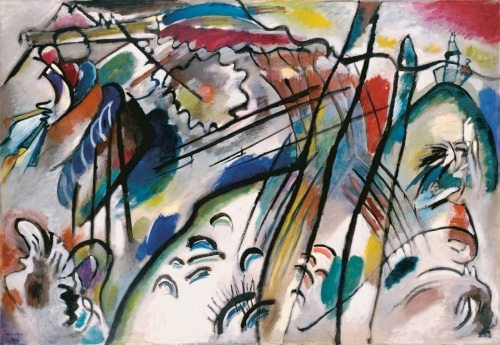|
The early 20th century brought with it many social, political and technological changes. The world was changing and as a result the artists and artworks of the time changed with it. This was especially true of Germany, where an expanding empire, rapid industrialization and prewar anxieties manifested in several unique artistic movements which are often categorized under the larger umbrella known as German Expressionism. One artist working during this time was Wassily Kandinsky, whose non-figurative work pushed the boundaries of form. In his 1912 painting, Improvisation No. 28, Kandinsky sought to express both his own philosophy and to engage whomever might view his work. Kandinsky was a founding member of the Der Blaue Reiter Group along with Franz Marc and Gabriele Münter. An offshoot of the German Expressionist movement, the Der Blaue Reiter Group looked to the prewar society prior to World War I in Germany and saw it lacking. The rise of industrialization and growing urbanization cultivated a sense of alienation in the members of the Der Blaue Reiter Group, who sought to alleviate their isolation through the expressive power of their art. Works like Kandinsky's Improvisation No. 28 worked to convey this underlying philosophy of the Der Blauer Reiter, turning away from the industrialization of the age and instead focusing their attention upon the organic, innate ability of an artist to disclose their own personal expression. Improvisation No. 28 is packed with energy, bright colors and dynamic shapes and lines. Unlike the majority of Western Art that preceded it, Improvisation No. 28 is largely abstract and non-objective. Instead Kandinsky allows the expressiveness of both color and the strokes of his brush to stand in place of the figurative works of the past. Arranged with a sense of organic chaos, the shapes and lines of Improvisation No. 28 are scattered across its surface in strange yet wonderful juxtapositions. Seeking to find a visual language outside of the usual objective representation of form, Kandinsky took inspiration from the intangible elements of life, like music, to express his artistic point of view and to elicit an emotional response from the viewer. To do this he used line and splashes of bold colors, adopting the saturated and vibrant colors of the Fauvists. Kandinsky strongly believed that line and color carried psychological and spiritual ability to communicate emotionally with their audience. This allowed the artist, art, and people to connect over their shared reactions while fighting the alienation which he felt was so predominate within German society. In Improvisation No. 28, the colors are used to highlight and underscore the black lines which twist, turn and bisect Kandinsky's canvas as the colors shift from warm hues in the upper right corner to blues and greens in the center and back to oranges and purples in the lower left corner. Line and color both are staggered, allowing the viewer's eye to roam the surface of the composition and settle on the details which speak to them. By creating work which was reactive, artists like Kandinsky were reacting themselves to the culture which surrounded them. Dissatisfied with the world at large, they sought to change it, to bring connection where there was alienation and spirituality to where industrialization dominated. In his work Improvisation No. 28, Kandinsky uses color and line to arouse an emotional connection within the viewer through his exposure of his own personal expression, in the hope that the artist could incite change within the world of their audience.
0 Comments
Leave a Reply. |
AuthorCrystal has a MA in the History of Art from Courtauld Institute of Art as well as a BFA in Art History from the Academy of Art University. Archives
November 2017
Categories
All
|



 RSS Feed
RSS Feed